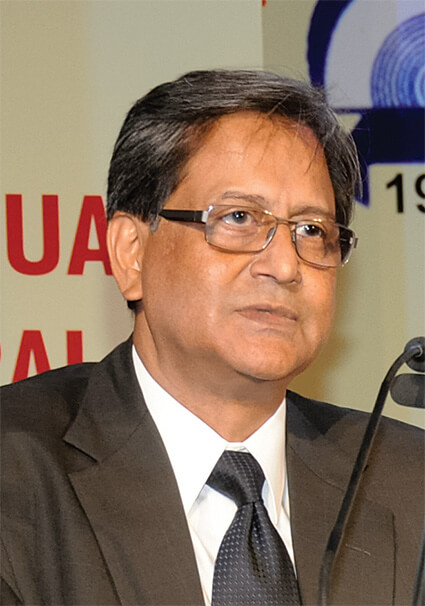

India’s first machine-made paper was manufactured in 1812. And gradually, with the rise in population and broadening of education, the demand for paper also escalated consistently. Every industry was changing globally. These changes over the decades with various expansions in terms of products and more balanced consumer-buyer relationship has made India one of the major players toady in the global paper scenario.
In the 53rd AGM and conference of the Federation of Paper Trader’s Association of India, Kolkata, Mr. Ashish De, Chief Advisor, Emami Paper Mills Ltd. took us to an in-depth journey of the paper contemporaries in a power-packed presentation titled, “The Changing Scenario in Paper Business- Kal, Aaj Aur Kal…”
Paper Mart brings you a special report:
Yesterday, Today and Tomorrow
Kal
According to Mr. Ashish De, this century old industry had been very rigid. With limited aspirations of common people, the market was more of a seller’s market. In the seventies and the eighties, fewer paper mills were present. The yesteryears have seen quite adamant sellers who would not necessarily seek a customer’s opinion. The market did not offer much in the respect of product choices, and a customer was bound to choose from whatever was offered irrespective of quality. Moreover, the “License Raj”, or “Permit Raj” was limiting the impending expansion of enterprises led by visionary entrepreneurs at that time. Being “Indian-made” also made the customers skeptical towards the quality of the products hampering the sales. Prior to the advent of economic liberalization in 1991, economy was very rigid with almost no global interaction. The result was slow and poor growth with no considerable innovation.
Aaj
Post-liberalization, by virtue of increase in product variety and increase in economies of scale, with the aid of modern supply and distributions solutions, Indian paper industry today is at an interesting crossroad. Compared to the market structure of the ’70s-’80s dominated by public sector enterprises, we observe a very distinct shift. Giving us a brief of the changing business protocols today, Mr. De said, “It is a buyer’s market, and the customer’s demand is the seller’s command. There are ample options in terms of product and quality. Being “Indian-made” is not a differentiator for quality. Globalization has exfoliated the cut-throat competitive instinct of the factory owners and traders. With the advent of media into our lives, we as customers are more aware of what is trending in terms of products. With improved living standards, the demand for quality and the product’s utility have changed. Today, the industry has about 850 paper and board mills which are operational in India.”
Kal
Mr. De explained how the present is molding up the future prospects of the industry. Now, business strategies focus on offering delight services to customers. The business is driven according to the customer’s choices. Also, new government is seen as great hope both for the customers and the producers. Here, the choice services to customers and returning the genuine value for money invested will be the key differentiator. Strong technology will backup and strengthen the different levels of production. Although Mr. De suggests that life will certainly be more challenging on the supply side. It will be a point-of-purchase (POP) scenario where the point of purchase for products and services becomes an important focus for marketers, because consumers tend to make purchasing decisions on very high-margin products or services at strategic locations.
Industry Today
Explaining the prospects in-store for the industry, Mr. De said, “India is among the top 12 global players with more than 13.5 million tonnes of annual consumption. It is estimated to achieve a turnover of Rs. 35,000 crore. The GDP is expected to touch 8.5 percent in the coming years, currently which is 5.63 percent. The paper industry will surely be a noticeable contributor in the GDP growth. Especially, the packaging board and tissue paper segment will lead the growth path. The pulp and paper industry will not vanish like many others because of the growth in packaging and printing.”
The Transformation
Unlike the yesteryears, the price is no longer controlled by the paper mills or paper traders. According to Mr. De, the buyer is in total control of the product prices. He explained, “To extract profit from the prices offered by the customer, the mill owners and paper traders must understand the customer’s business dynamics to crack that extra value in servicing customers and gain that marginal profit.
The “delivery on time” is a very crucial factor in image building. It is the responsibility of the team at the supply end who has to keep a close eye on delivery that should be done in the allotted time. The OTIF (on-time-in-full) delivery must be maintained at any cost.
Technical up-gradation is another factor to remain at the helm. Automated control system tipped with latest technology is critical to efficient industrial operations. Machines must be tried and tested on the basis of efficiency before installation. All the aforementioned pointers reflect one thing only that customer is the prime driver of business. Here, the supply chain needs to be controlled by the mills and channel partners to ensure the smooth business operation of the customers.”
Challenges for Traders
Speaking about the challenges paper traders are encountering, Mr. De said, “’what do we know? What have we learnt?’- This famous quote by Steve Jobs is very aptly applicable in our industry. We must question ourselves and our strategies and keep in mind the following pointers: How can we earn more respect from the customer? How can we grow together profitably? How can we add more value to the customers business rather than just playing the role of a financier? How to achieve the right balance between the customer and the mill? How could we know more about the capability/limitation of the mill to strike? After getting the answers of these industry pertinent questions, we could easily discern the positive shift in our business output. Moreover, new international business penetration into market is a big challenge to indigenous industry and may cause a threat to small and second level dealers.”
Solutions
The change in buyer’s behavior, the nature of demand in the paper industry and government’s effective role in not only sustaining but enhancing the paper demand, Mr. De reflected, “Today, a customer is much more aware of products. The changing buyer’s behavior in urban markets needs to be keenly observed by the mill owners and traders to have a better understanding of the nature of demand. The Government’s efforts to improve the literacy and education are thus necessary to keep the demand of paper alive in the country.”
Mr. De further explained, “Increased disposable income leads to higher spending. With the arrival of modern media and myriads of communication channels, even rural India is aspiring for a better lifestyle, which in turn will increase the demand of consumer items and the need of packaging.
“FDI in retail has led to substantial jump in paper and board demand. A great surge in the manufacturing sector is expected with the growing needs for paper and board. Here, the industry needs to apply 4 “R” viz. re-think; renovate; re-position; re-designate.”
Mr. De also emphasized the importance of e-commerce, and added, “e-commerce has created a new wave. The e-retail comprises USD 2.3 billion business which is likely to shoot up to USD 32 billion by 2020. The total retail market size is USD 525 billion in which USD 479 billion is unorganized size and USD 44 billion is organized.
“The total retail market is expected to expand to a growth of USD 1040 billion by 2020 with a growth of USD 150 billion in organized retails and USD 850 billion in unorganized retails.”
He also added that there is some possibility of big international trading houses to enter the Indian market.
Manufacturers’ Expectation from Trade Partners
This segment of the presentation stressed on establishing an excellent customer relationship by maintaining transparency in terms of prices, being attentive to customer queries and facilitating on-time service delivery.
The traders must acquire adequate technical knowledge to handle even minor complaints and to build infrastructure capable enough to meet the expectation of the customers. Also, sufficient finances must be invested in the profitable customers’ business. The mill owners and traders must acquire the ability to cover the market extensively so as to share all issues with mills.
Mr. De concluded, “There is an urgent need to create enthusiasm and interest in the next generation of your team, more youth should be allowed to participate in the business to secure the future of the paper and pulp industry in India. Business is never easy and there’s a saying that no matter how well-organized an industry is, the business is run by how well equipped its people are…All the Best!”



